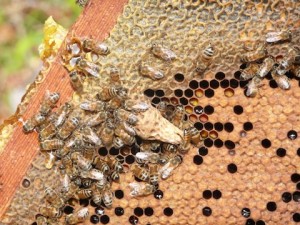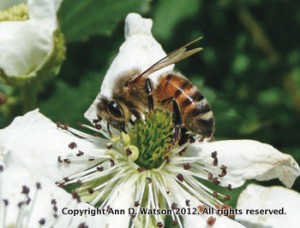Live from the Hive: July 2014
 “The Making of a Queen” by Annie Watson, Thistle Hill Studio
“The Making of a Queen” by Annie Watson, Thistle Hill Studio
In this picture you see a “queen cup” — an elongated cell, looking a bit like an ice cream cone, that contains a queen bee larva. The bees are making a new queen, which they do when the queen dies, is failing, or has left the hive with a swarm. A fertilized egg develops into a queen when the workers feed a fertilized egg with a rich food made of honey, pollen, and enzymes, called Royal Jelly. Because she will be a very large bee, she needs a larger cell to grow in.
The queen bee is born with all of the eggs she’ll ever lay in her extra-long abdomen. Once she has mated she deposits one tiny white egg in each cell of honey comb at the rate of up to 2,000 eggs a day at the peak of the spring buildup. But this egg laying is tied to the sun, seasons, and length of the day. The summer solstice having passed on June 21, the queen has begun to slow down in preparation for winter.
The slightly convex cells at the top of the picture are capped honey cells, while the reddish brown, slightly puffy cells further down contain larvae. The uncapped yellow cells contain pollen. Note the “courtier” bees who are tending the queen cell.
 “Blackberry Bloom” by Annie Watson,
“Blackberry Bloom” by Annie Watson,